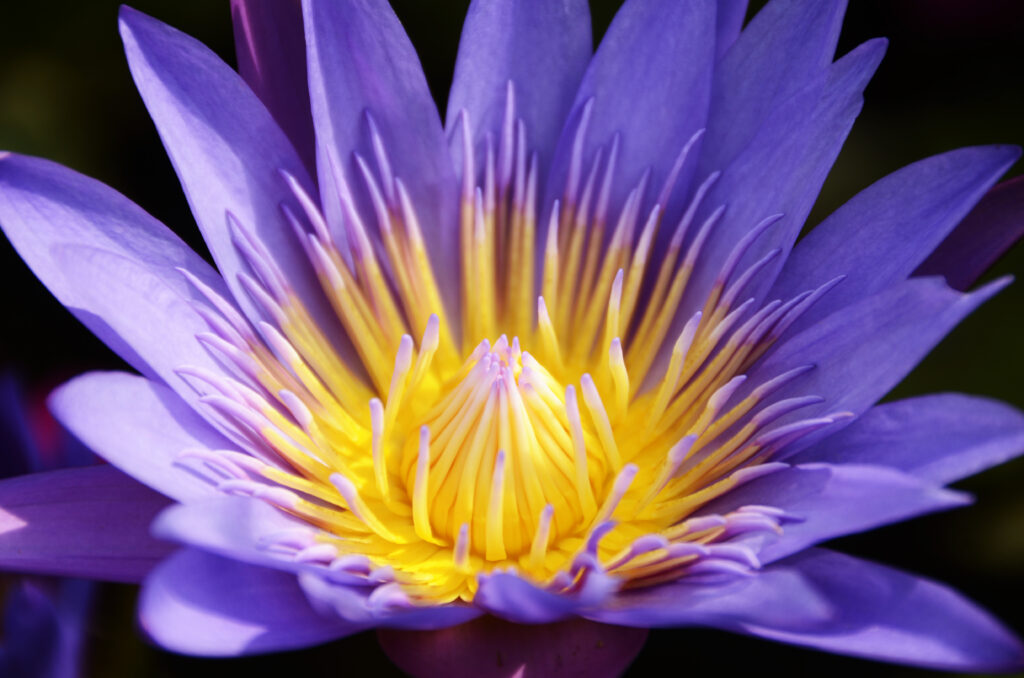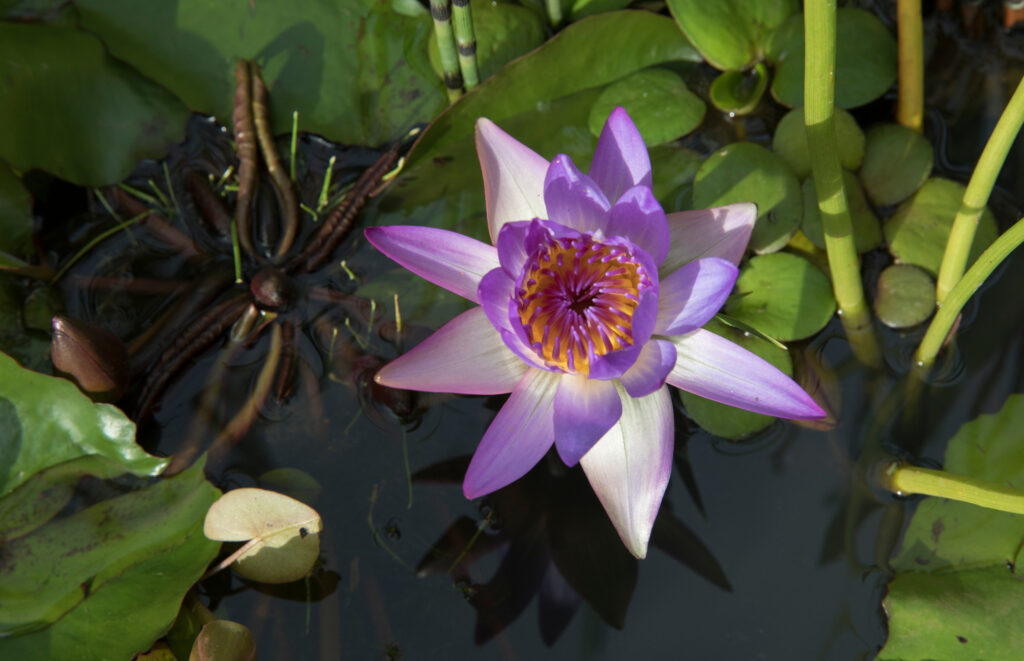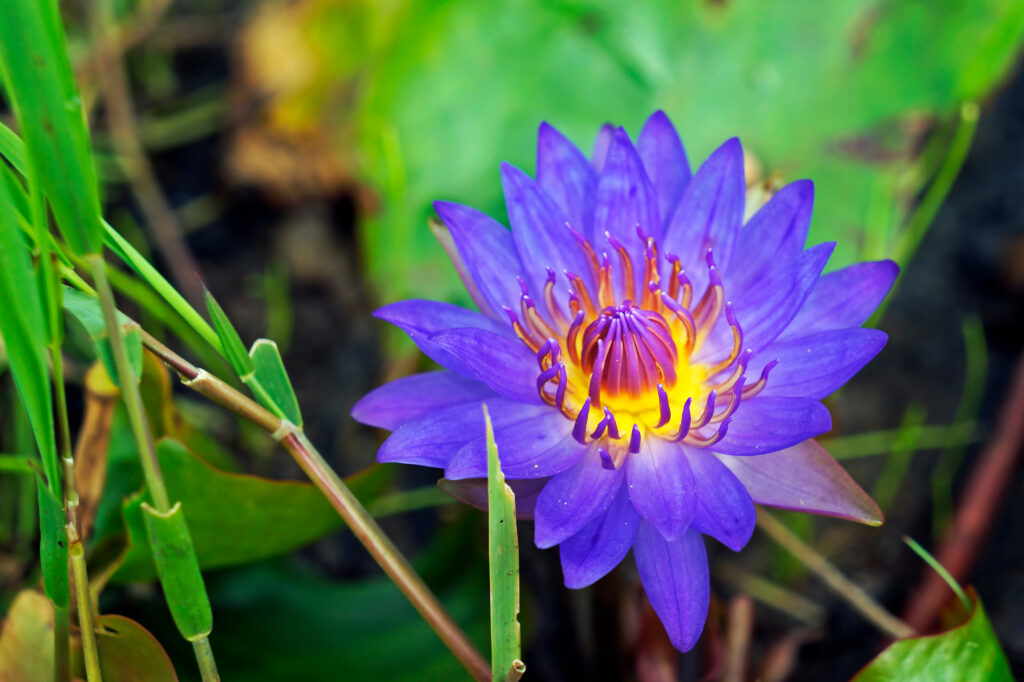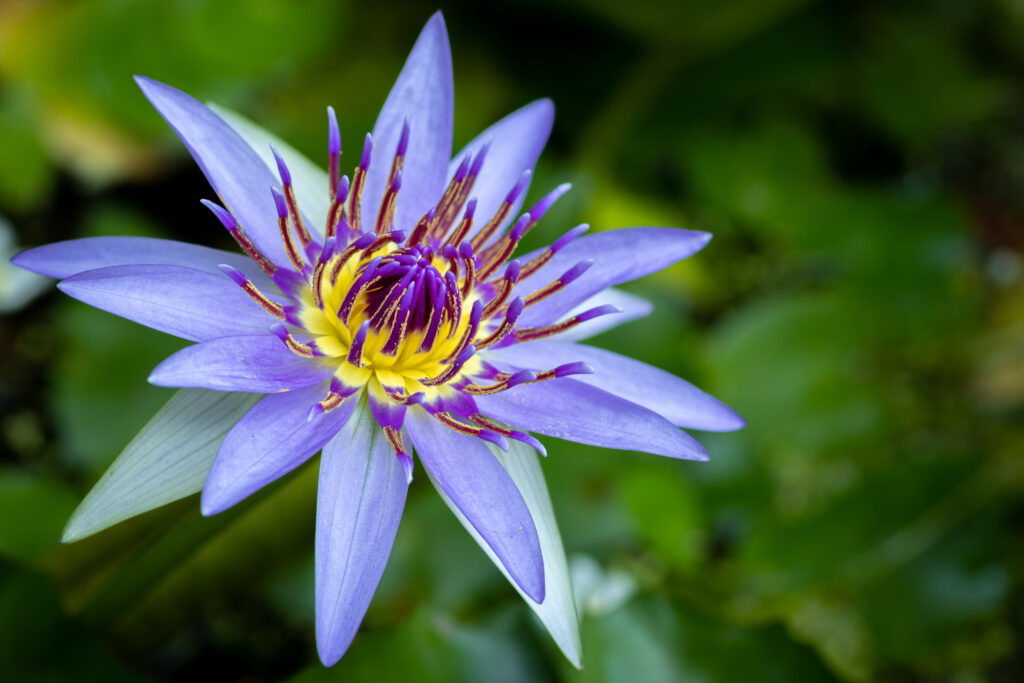Introduction
Water lilies are one of the most popular flowering plants in the world. With over 100 species and countless hybrids, they come in many colors, shapes, and sizes. These aquatic perennials produce dramatic flowers and large leaves that embellish any body of water.
In addition to their beauty, they can aid the ecosystem by lowering the water’s temperature, absorbing nutrients to keep it clear, and sheltering fish from predators under their pads. There are two types of water lilies, hardy and tropical, but only the latter comes in blue shades and produces larger flowers and leaves than their counterpart.
In this article, we’ll explore the different types of blue lilies, their characteristics, and how to care for them.
Types of Blue Lilies

These blue lilies open at dawn and close at sunset.
©Simon Groewe/Shutterstock.com
Nymphaea ‘August Koch’
These cultivars have wide, oval-shaped flowers with jagged edges that serve as a backdrop to flowers with lilac-colored petals and stamens that resemble a flame.
They open at dawn and close at sunset, blooming from summer to fall. Each blossom lasts 3-4 days, and new ones bloom once they die, producing a continuous stream of flowers.

‘Director George T. Moore’ blooms all summer.
©Ivan Yohan/Shutterstock.com
Nymphaea ‘Director George T. Moore’
These varieties have round, large pads with purple blotches that curl towards their toothed edges. Star-shaped, light blue flowers with a yellow and purple center emerge among them.
They open as the sun rises and close when it leaves, blooming all summer. Every time a flower dies, which happens every three to four days, a new one blooms. You’ll need a large, still pond to accommodate their large leaves, with constant sunlight.

Plant these blue lillies in a still pond with plenty of sunlight for optimal results.
©pisitpong2017/Shutterstock.com
Nymphaea ‘King of Siam’
The most stunning of the group, these varieties have brown-speckled leaves contrasting with imposing, deep violet flowers. Instead of stamens, they have petals that shrink in size toward a golden center, which gives them a unique look and a more potent fragrance.
They bloom from summer to fall, opening in the morning and closing when the sun goes down, and continuously produce flowers that last between three and four days. Plant them in a still pond with plenty of sunlight for optimal results.

Despite their name, Nymphaea ‘Midnight’ blooms during the day.
©Jockey/Shutterstock.com
Nymphaea ‘Midnight’
Midnight water lilies, one of the first hybrids to modify the stamen, have irregularly shaped dark green pads and deep-violet flowers with a deep yellow center. Their anthers were modified into thin petals, giving them an impactful look.
Despite their name, they bloom during the day, close at night, and produce many flowers that live for three or four days. They have a mild scent and need partial shade to thrive.

These tropical plants need warm weather, full sun, and occasional shade.
©Gonzalo de Miceu/Shutterstock.com
Nymphaea ‘Tina’
These cultivars produce deep-green, wavy leaves and flowers with aquamarine petals and multi-colored stamens that are the stars of the show.
To survive, these tropical plants need warm weather, full sun, and occasional shade. Expect their flowers to last three to four days and to bloom over the summer.

Ancient Egyptians ingested these blue lillies for ritual purposes.
©Wagner Campelo/Shutterstock.com
Nymphaea caerulea
These species may be the most well-known and culturally significant, having been grown for centuries. They have medicinal qualities, and ancient Egyptians ingested them for ritual purposes. Their green, rounded leaves lay on the water, and flowers with blue petals and showy stamens rise above them.
They bloom all summer as long as they are in still water which gets plenty of sunlight, and need ample waterbody due to their large pads.

are perfect for smaller ponds or containers.
©Nilanka Sampath/Shutterstock.com
Nymphaea colorata
Native to East Africa and registered in 1928, botanists have used this species of water lily to create many cultivars and hybrids. They have round leaves and mauve-colored flowers with a deep yellow center full of purple stamens.
Since their leaves aren’t large, these plants are perfect for smaller ponds or containers, provided they get full sun and protection from wind.
Growing and Caring for Blue Lilies
Since blue lilies come from tropical varieties of water lilies, they can only survive in warm climates. Because of this, you should plant them if you’re in USDA plant hardiness zones 9–11. Since they are aquatic plants, you need to bury them in a body of water at least 2 feet deep with soil rich in organic matter with a stabilizing gravel layer.
Due to their sensitivity to the cold, it’s best to plant them in a container until your pond’s water stabilizes at 70 degrees Fahrenheit. While they grow, you should fertilize them every 2-3 weeks and ensure they get a minimum of five hours of direct sunlight.
Aphids, moths, and beetles may attack your lilies, which you can shove into the pond to feed your fish if you have any. They can also catch diseases such as crown rot or leaf spot, and crown rot may lead you to discard the affected plant.
Remove dead flowers from the pond by cutting them from the stem to ensure constant blooming. Water lilies make conspicuous cut flowers but need sugar, bleach, and aluminum sulfate to keep them from quickly wilting.
After summer, you should lift the plants from the soil and store their roots in a container filled with damp sand and moss, keeping them in an aquarium until spring.
The photo featured at the top of this post is © Wagner Campelo/Shutterstock.com
FAQs (Frequently Asked Questions)
How do you propagate blue lilies
You can propagate blue lilies by splitting one of their roots into segments and planting them in containers. Alternatively, you can plant the seeds they produce, although their genetic information may differ, which could yield different-colored flowers.
What are some popular uses for blue lilies?
Blue lilies are the perfect decoration for artificial ponds and beautify floral arrangements if appropriately preserved.
What is the meaning of blue lilies?
The Egyptians gave them great ornamental value and considered blue lilies sacred flowers that symbolized the sun and rebirth.
Thank you for reading! Have some feedback for us? Contact the AZ Animals editorial team.






